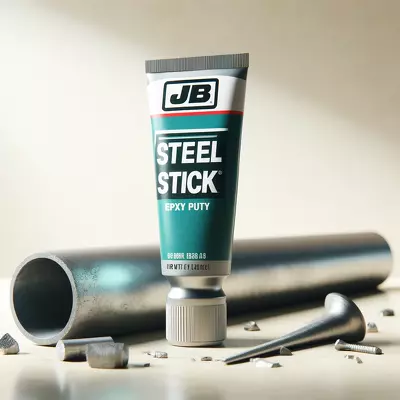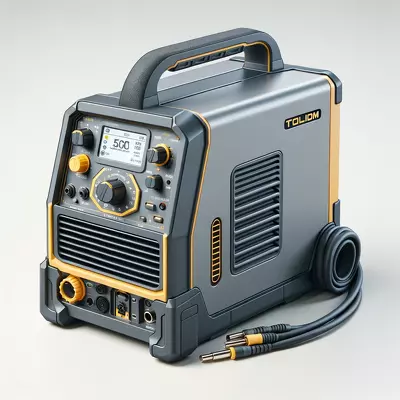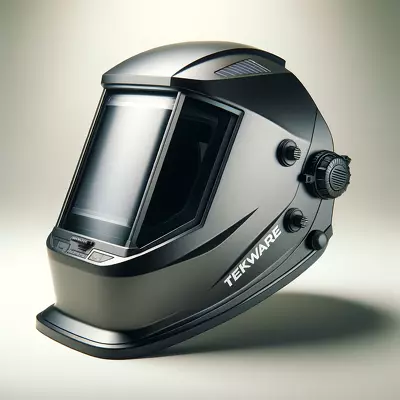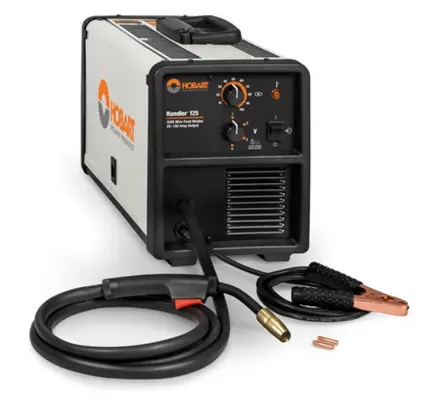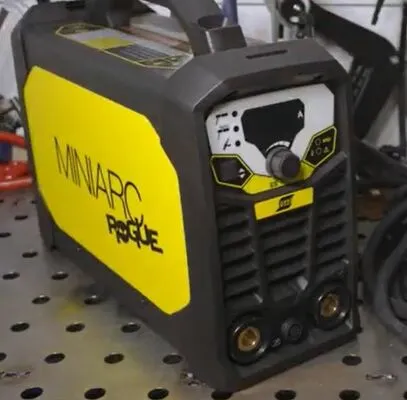ESAB EM 210 MIG Welder Review: Transform Your Welding Experience Today

Exploring the world of welding, the focus shifts to an in-depth analysis of a standout machine that has garnered attention for its performance and reliability. The EM 210 model from ESAB, a brand synonymous with quality in welding technology, offers both novices and seasoned professionals a tool that promises precision and efficiency in MIG welding tasks.
As an Amazon Associate, we earn a commission from qualifying purchases.
I. Introduction
A. Overview of Welding Technology
Welding stands as a cornerstone in the construction and manufacturing industries, offering a method to join materials, typically metals or thermoplastics, with high strength and durability. This technique has evolved over decades, incorporating advanced technologies that enhance precision, efficiency, and safety. The choice of welding equipment plays a pivotal role in achieving desired outcomes, influencing the quality of welds, productivity, and operator comfort.
B. Importance of Choosing the Right Welder
Selecting the appropriate welder is crucial for any project, as it directly impacts the integrity of the weld, the speed of completion, and overall costs. A well-chosen welder ensures compatibility with the materials being joined, meets the demands of the task at hand, and aligns with the user’s skill level. With various types available, from MIG and TIG to stick welders, understanding each type’s capabilities and limitations is essential for making an informed decision.
II. ESAB EM 210 MIG Welder Overview
A. Specifications and Features
The ESAB EM 210 is a versatile MIG welder designed for both professional and amateur use. It boasts a user-friendly interface, making it accessible for beginners while still offering the advanced features that professionals require. The welder operates on both 120V and 230V, providing flexibility for different power supplies and welding needs. It supports a wide range of wire diameters and has a generous welding amperage range, accommodating various materials and thicknesses.
B. Design and Build Quality
Constructed with durability in mind, the ESAB EM 210 features robust metal housing that withstands the rigors of both workshop and on-site use. Its compact design enhances portability, making it an excellent choice for projects requiring mobility. Attention to detail in its build quality ensures long-term reliability and performance, setting it apart from competitors.
C. Ease of Use and Setup
The EM 210 is renowned for its straightforward setup and operation. Its intuitive control panel simplifies the selection of welding parameters, allowing for quick adjustments and optimal welding conditions. The welder’s automatic settings feature aids beginners in achieving professional results, while its advanced options cater to the experienced welder’s needs for customization.
III. Performance Analysis
A. Welding Capability and Versatility
This welder demonstrates exceptional versatility and is capable of handling a broad spectrum of welding tasks, from thin sheet metal to thicker structural components. Its superior arc quality ensures smooth, strong welds across a variety of materials, including steel, stainless steel, and aluminum. The ESAB EM 210’s adaptability makes it a valuable tool for diverse projects, from auto repair to fabrication work.
B. Durability and Reliability
Long-term reliability is a hallmark of the ESAB EM 210, with many users reporting consistent performance over extensive periods of use. Its design prioritizes component protection, reducing the likelihood of overheating and wear. Regular maintenance is straightforward, contributing to the welder’s overall durability and lifespan.
C. Comparison with Competing Models
When compared to its counterparts, the ESAB EM 210 stands out for its balance of power, portability, and user-friendly features. It offers a competitive edge in ease of use without sacrificing performance or versatility. Its reliability and build quality often surpass those of other welders in its class, making it a preferred choice for both professionals and hobbyists.
IV. User Experience
A. Feedback from Professionals
Professionals commend the ESAB EM 210 for its consistent performance and adaptability to various welding tasks. Its reliability for daily, heavy-duty use and the quality of its welds are frequently highlighted, with many appreciating the precision and control it offers.
B. Feedback from Hobbyists
Hobbyists praise the welder for its ease of use, making it an excellent entry point into welding. The automatic settings and straightforward interface allow beginners to achieve high-quality welds with a minimal learning curve. Its portability is also a significant advantage for those with limited workspace or who require a welder that can be easily moved.
C. Commonly Highlighted Pros and Cons
Users universally appreciate the welder’s reliability, versatility, and user-friendly design. However, some note the initial cost as a consideration, though many argue that its performance and durability offer excellent long-term value. The need for additional accessories for specific tasks is mentioned, though not seen as a major drawback.
V. Cost-Effectiveness
A. Initial Investment vs. Long-Term Value
The ESAB EM 210’s price point is competitive, reflecting its advanced features and robust build. While the upfront cost may be higher than some entry-level models, its longevity, reliability, and the quality of welds it produces justify the investment, offering significant long-term savings in terms of reduced repair and replacement costs.
B. Running Costs and Maintenance
Operational expenses remain low with the EM 210, thanks to its efficient design and the availability of affordable consumables. Maintenance is simplified by the welder’s durable construction and easy access to components, ensuring that it remains in optimal condition with minimal effort.
C. Availability of Accessories and Parts
ESAB supports the EM 210 with a comprehensive range of accessories and readily available replacement parts, enhancing its functionality and extending its service life. This accessibility ensures users can adapt the welder to their specific needs and maintain its performance at a high level.
VI. FAQs
Q: What power requirements does the ESAB EM 210 MIG welder have?
A: The ESAB EM 210 can operate on both 120V and 230V power outlets, making it adaptable to various environments and power sources.
Q: Can the ESAB EM 210 be used for aluminum welding?
A: Yes, with the appropriate spool gun attachment, the ESAB EM 210 is capable of welding aluminum effectively.
Q: What is the maximum thickness the ESAB EM 210 can weld?
A: The ESAB EM 210 can weld up to 3/8-inch thick steel in a single pass when using the proper settings and conditions.
Q: Is a gas cylinder included with the ESAB EM 210 MIG welder?
A: No, gas cylinders are typically sold separately from the welder. You will need to purchase an appropriate gas cylinder for MIG welding.
Q: Does the ESAB EM 210 come with a warranty?
A: Yes, the ESAB EM 210 comes with a manufacturer’s warranty. The terms and duration can vary, so it is recommended to check with the supplier or manufacturer for specific warranty information.
Q: Are there any special maintenance routines recommended for the ESAB EM 210?
A: Regular maintenance, such as cleaning the machine, checking the wire feeder, and replacing consumables like tips and nozzles, will help maintain the welder’s performance. The user manual outlines detailed maintenance routines.
Q: What is the weight of the ESAB EM 210 MIG welder, and is it portable?
A: The ESAB EM 210 is designed with portability in mind, weighing in at a manageable weight that allows it to be relatively portable for on-site jobs and workshop mobility.
Q: What are the key differences between the ESAB Rebel EMP 215ic and the ESAB EM 210 MIG Welder?
A: The ESAB Rebel EMP 215ic is a multi-process welder that supports MIG, Flux-Cored, DC TIG, and Stick welding, making it highly versatile for various welding tasks. In contrast, the ESAB EM 210 MIG Welder is specifically designed for MIG and Flux-Cored welding, providing a straightforward and user-friendly experience for those specific welding processes.
Q: How does the Hobart Ironman 230 compare to the ESAB EM 210?
A: The Hobart Ironman 230 is another powerful MIG welder known for its durability and performance. It’s suitable for more industrial applications and can handle a higher output compared to the ESAB EM 210.
VII. Conclusion
A. Review Summary
The ESAB EM 210 MIG Welder has proven to be a versatile and robust tool for both professional welders and hobbyists. Its dual voltage capability, ease of use, and wide range of applications make it a strong contender in the welding market. This welder stands out for its fine balance of functionality, portability, and reliability, making it a solid choice for a broad array of welding tasks.
B. Best Alternative
A comparable alternative to the ESAB EM 210 is the Miller Millermatic 211. Like the ESAB, it operates on both 120V and 240V, but it also features Advanced Auto-Set, which allows for even easier adjustments for different materials and thicknesses. The Millermatic 211’s inverter technology also makes it lighter and more energy-efficient, which could be a deciding factor for those who prioritize portability and energy consumption.
VIII. Suggested Readings
Before diving into your next welding project or making a decision on your next welder purchase, enriching your knowledge with further reading can be incredibly beneficial. Here are a few suggested titles that offer valuable insights into welding techniques, equipment selection, and project ideas:
- “Welding For Dummies” by Steven Robert Farnsworth – A comprehensive guide for beginners that covers the basics of welding, including equipment, techniques, and safety tips.
- “The Welding Business Owner’s Hand Book” by David Zielinski – Offers practical advice for starting and managing a successful welding business, including how to select the right equipment.
- “Modern Welding Technology” by Howard B. Cary and Scott C. Helzer – This book provides an in-depth look at the latest welding technologies, techniques, and applications, suitable for both students and professionals.
- “Welding Principles and Applications” by Larry Jeffus – A widely used textbook that covers a broad range of welding techniques, with detailed explanations and illustrations.
- “The Complete Guide to MIG Welding” by Roger Timings – Focuses specifically on MIG welding, offering tips, tricks, and step-by-step instructions for various projects.
These readings not only offer a wealth of knowledge for both the novice and seasoned welder but also serve as valuable resources for understanding the broader context of welding technology and its applications.
Whether you’re looking to deepen your technical knowledge, explore new welding projects, or start a welding business, these books provide essential insights and guidance to help you achieve your goals.

